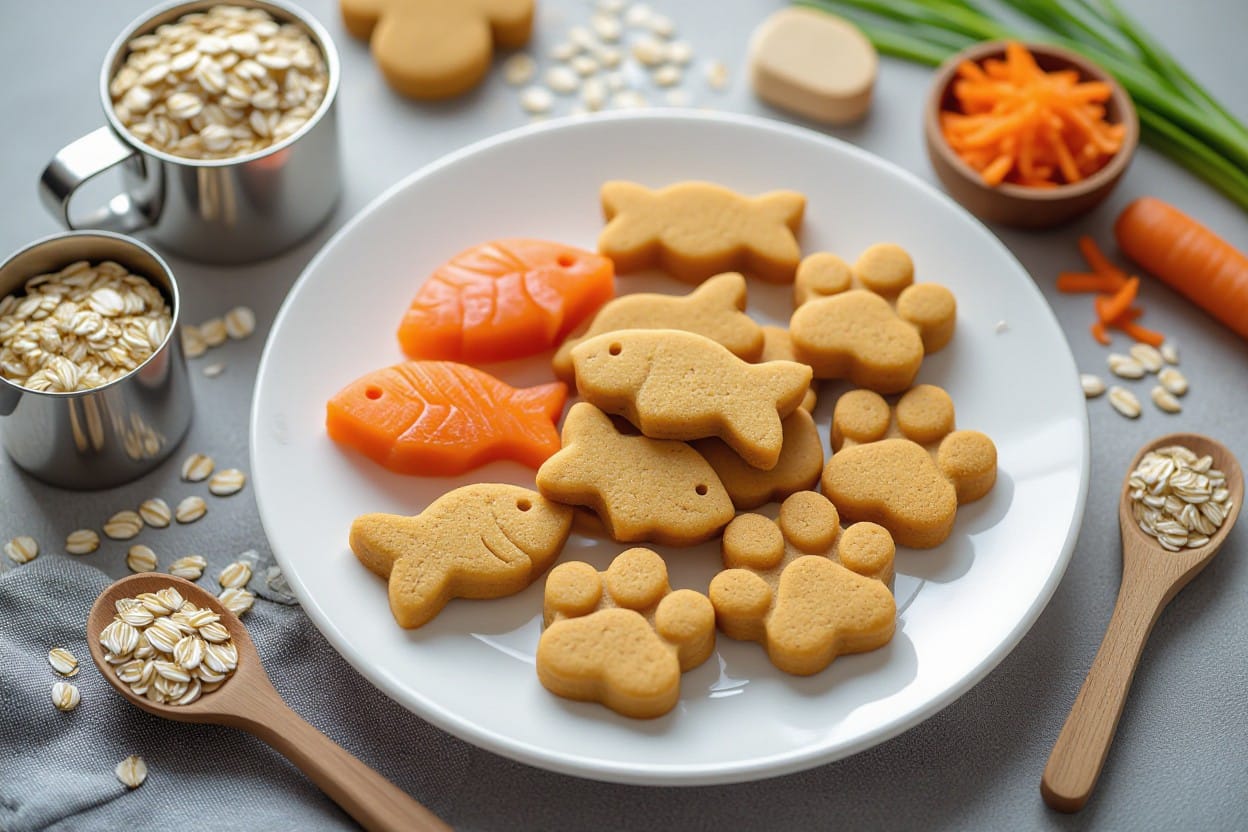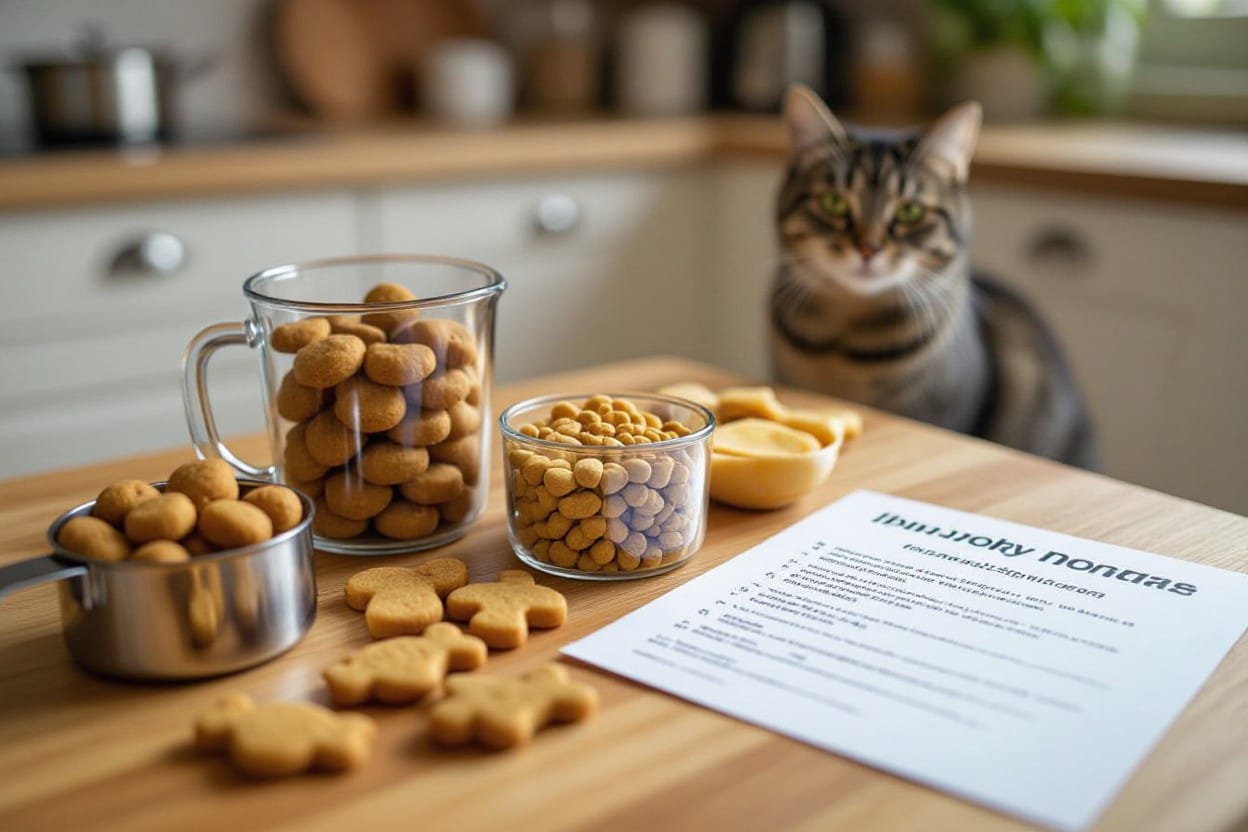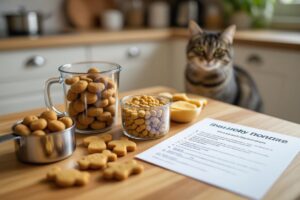It’s important you choose homemade cat treats recipes that are both delicious and nutritious so your cat enjoys snacks that support health; this vet-approved roundup gives you simple, protein-focused options and baking tips. You get clear ingredient swaps, portion guides, and warnings about dangerous ingredients like onions, garlic, chocolate, and xylitol that must be avoided. Follow recipes that emphasize high protein, low fillers, and controlled sodium to keep your cat safe and satisfied.

Key Takeaways:
- Provides 50 vet-approved, balanced recipes of homemade cat treats recipes that are both delicious and nutritious, prioritizing high-quality protein and cat-safe ingredients.
- Includes variety for different needs—low-calorie, limited-ingredient, dental and training treats—making it easy to tailor healthy homemade cat treats to individual cats’ diets and sensitivities.
- Strong search impressions but 0 clicks signal an opportunity to boost CTR: front-load the main keyword in title/meta, use enticing descriptions and images, and test variations of “homemade cat treats recipes” and “healthy homemade cat treats” to improve visibility.

Understanding Cat Nutrition for Treats
The Basics of Feline Nutrition
Cats are obligate carnivores that depend on high-quality animal protein, adequate fat, and moisture more than carbohydrates; adult maintenance diets typically meet a minimum of ~26% crude protein and ~9% fat on a dry-matter basis per AAFCO guidelines. Keep treats to about 10% of your cat’s daily calories—an average indoor adult cat needs roughly 200–300 kcal/day, so total treat calories should generally stay in the ~20–30 kcal range to avoid weight gain.
Focus your homemade cat treats recipes that are both delicious and nutritious around lean cooked meats, small amounts of fish, or egg, and avoid filling treats with starch-heavy ingredients that provide little feline-specific nutrition. If you use freeze-dried or baked options, calculate portion sizes: a few small bites (for most recipes) should equal no more than a single teaspoon to a tablespoon of final product per treat-giving session.
Essential Nutrients for Cats
Animal-source amino acids like taurine and arginine are nonnegotiable—taurine deficiency can lead to dilated cardiomyopathy and retinal degeneration. Cats also require preformed vitamin A (cannot convert beta-carotene), long-chain arachidonic acid, and sufficient B vitamins and minerals (calcium, phosphorus, potassium) in balanced proportions; treats should complement rather than dilute those vitals.
Choose ingredients that add targeted nutrients: small amounts of cooked liver supply vitamin A and B12 but limit liver to avoid hypervitaminosis A; cooked egg provides high-bioavailability protein and biotin when cooked; plain cooked fish or lean poultry supplies both protein and taurine. Avoid including onions, garlic, grapes, raisins, chocolate, and xylitol in any homemade treat—these are toxic to cats—and be cautious with dairy because many cats are lactose intolerant.
Commercial nutrient profiles exist to guide you: AAFCO minimums (adult maintenance) are a useful benchmark, so design treats that don’t push overall daily intake away from those targets. Use treats to top up or reward—examples include 1–2 small freeze-dried chicken hearts for taurine and protein, or a teaspoon of blended cooked salmon for omega-3s—rather than as a primary nutrition source.
Importance of Protein in Cat Treats
Protein supplies vital amino acids and should be the dominant macronutrient in your treats; animal proteins have superior digestibility and bioavailable taurine compared with plant sources. Aim for recipes where animal protein is the first ingredient—examples that work well: cooked chicken breast, turkey, lean beef, egg, or small portions of cooked oily fish like salmon (used sparingly for fat).
Portion control matters because even high-protein treats add calories; organ meats are nutrient-dense but keep liver to no more than a few grams per week for an average cat to avoid vitamin A overload. If your cat has kidney disease, consult your vet—you may prioritize high-quality protein but adjust total protein and phosphorus intake under medical guidance.
Raw-protein options increase the risk of bacterial contamination, so either cook proteins thoroughly or use reputable freeze-dried products; for most healthy cats, high-quality cooked or freeze-dried animal protein treats are safe and effective ways to make your homemade cat treats both delicious and nutritious while limiting health risk.
The Benefits of Homemade Cat Treats
Economic Advantages
You can cut long-term costs by making treats at home: a simple batch using 1 lb of boneless chicken and a cup of oat flour often yields 80–120 small bites for roughly $4–$6, putting the per-treat cost around $0.03–$0.08. Commercial premium treats commonly run $0.06–$0.15 per piece, so if you give 5 treats a day you could save roughly $60–$120 in a year just on treat purchases.
Small equipment like a cookie sheet and freezer bags amortizes quickly, and you can lower costs further by using leftover cooked meat or buying proteins in bulk. Making treats yourself also reduces single-use packaging and lets you turn inexpensive pantry staples (pumpkin, canned fish, cooked legumes) into homemade cat treats recipes that are both delicious and nutritious.
Quality Control of Ingredients
You choose the protein, fat, and carbohydrate sources rather than trusting labels. Opt for lean cooked proteins (chicken breast, turkey, salmon in moderation) and whole-food binders like pumpkin or oat flour; avoid fillers such as high-fructose syrups and excessive sodium. Avoid toxic ingredients—onion, garlic, chocolate, grapes/raisins and artificial sweeteners like xylitol—and limit tuna to prevent mercury buildup.
Batch labeling and simple storage protocols give you additional control: refrigerate most baked or cooked treats for 5–7 days and freeze portions for up to 3 months. Check ingredient nutrition—sodium and phosphorus matter for cats with heart or kidney issues—and choose human-grade or minimally processed items when possible to reduce hidden preservatives.
For allergy-prone or sensitive cats, rotate single-protein batches and keep a log of reactions; inexpensive tests like an elimination diet over 6–8 weeks help pinpoint triggers. You can also add a vet-recommended taurine supplement if a recipe is low in this crucial amino acid, and use the USDA food database or package nutrition facts to calculate calories per treat before feeding.
Tailoring Treats to Your Cat’s Needs
Adjust recipes to match your cat’s life stage and medical needs: make soft, high-moisture treats for seniors with dental issues by blending cooked fish or chicken with low-sodium broth; create low-calorie rewards (≤10 kcal per treat) for weight management using pureed pumpkin or steamed green beans. Typical adult cats need ~200–250 kcal/day, so keep treats to no more than 5–10% of daily calories if you’re offering multiple rewards.
Specific health conditions call for ingredient tweaks: for chronic kidney disease lower phosphorus and sodium by avoiding organ meats and commercial broths; for urinary tract support emphasize water-rich wet-food–based treats and avoid high-magnesium additives. Novel proteins like rabbit or venison make good elimination-trial treats for suspected food allergies.
Measure portions with a kitchen scale and log weekly weight changes to verify effectiveness; swap wheat flour for oat or rice flour if you suspect grain sensitivity, and soften treats with egg or mashed sweet potato for cats with chewing problems. Always coordinate major dietary changes with your veterinarian to align treat composition with any prescribed therapeutic diet.
Ingredients to Use
Protein Sources
Lean, cooked meats should form the backbone of your recipes: boneless chicken, turkey, and firm white fish like cod provide high-quality amino acids that meet feline needs. AAFCO sets a minimum of about 26% crude protein for adult cat maintenance, so you’ll often use 1/2 to 1 cup of cooked meat per small batch; for example, 1 lb cooked chicken typically yields 40–50 bite-sized treats.
Whole eggs (fully cooked) and small amounts of organ meats—liver or heart—add concentrated nutrients and palatability; keep organ meat to no more than 10–15% of the total protein in a recipe to avoid vitamin A overload. Avoid raw protein sources: raw fish and raw eggs carry pathogens and enzymes that can destroy B-vitamins, and raw pork can harbor parasites.
Healthy Additives
Omega-3s from high-quality fish oil can support skin, coat, and joint health; add a few drops per batch rather than per treat to control dosage, and choose products tested for heavy metals. Taurine is an crucial amino acid for cats and often lacking in human-grade ingredients—use a vet-recommended taurine supplement when a recipe doesn’t include enough animal tissue, especially with fish-based treats.
Other beneficial add-ins include plain canned pumpkin for soluble fiber, a pinch of dried parsley or catnip for flavor, and small amounts of brewer’s yeast for B-vitamins. Stay away from flavor enhancers and human sweeteners: onion, garlic, chives, xylitol, chocolate, grapes/raisins are toxic and must never be used.
When you add supplements, follow manufacturer guidance and your vet’s recommendations; micro-dosing whole-batch additions—like 1 tablespoon canned pumpkin per 1/2 cup mix or a few drops of fish oil—lets you control calories and nutrients while keeping treats safe and balanced.
Carbohydrates and Fiber
Low-glycemic carbs like cooked sweet potato, rolled oats, and short-grain brown rice provide texture and a little slow-burning energy without spiking blood sugar. Use modest amounts—typically 1/4 to 1/2 cup cooked carbohydrate per batch—so treats remain protein-forward and suitable for obligate carnivores.
Soluble fiber sources such as canned pumpkin or mashed butternut squash help firm stools and aid digestion; clinical practice often recommends up to 1 tablespoon of canned pumpkin per day for a medium-sized cat, spread across treats or mixed into meals. Avoid raw dough (yeast risks) and starchy additives that contain seasonings or salt.
For fiber balance, combine soluble options with a teaspoon or two of cooked oats or brown rice per batch to maintain treat structure and palatability while supporting gut health; keep total carbohydrate content low so the treats remain aligned with homemade cat treats recipes that are both delicious and nutritious.
Ingredients to Avoid
Toxic Foods for Cats
Dark chocolate, cocoa powder, coffee grounds, and other sources of theobromine and caffeine can produce tremors, tachycardia, vomiting, seizures even with relatively small ingestions of concentrated products. Onions, garlic, leeks, and chives (all members of the Allium family) damage red blood cells and can cause hemolytic anemia; a single meal made with cooked onion or garlic powder has caused severe anemia in some cats. Grapes and raisins have been linked to acute kidney injury in companion animals, so avoid any baked goods that include them.
Artificial sweetener xylitol triggers rapid insulin release and acute hypoglycemia (and liver injury) in dogs, and although feline cases are rarer, you should exclude it completely from cat treats. Raw yeast dough can expand and produce ethanol in the stomach, leading to bloat and alcohol toxicosis; raw eggs risk Salmonella and avidin-related biotin deficiency. Bones, especially cooked ones, may splinter and cause choking or GI perforation—keep them out of treat recipes.
Allergens to Watch For
Common food allergens for cats include fish, dairy, beef, chicken, and wheat. Signs often show as chronic itching, recurrent ear infections, vomiting, or diarrhea rather than immediate hives; owners frequently see improvement only after an elimination trial of at least 8–12 weeks using a novel protein or hydrolyzed diet. If your cat has a known sensitivity, avoid combining multiple common proteins in one treat—single-protein formulas reduce diagnostic confusion.
When you formulate healthy homemade cat treats, prioritize novel or limited-ingredient proteins such as rabbit, venison, or duck if testing for food intolerance. Protein-first snacks (freeze-dried fish pieces, plain cooked turkey) typically provoke fewer allergic responses than complex, multi-ingredient bites that include dairy or grains.
Testing for food allergy often requires strict adherence: remove all suspected proteins and treats for the full trial period, then reintroduce one ingredient at a time to identify the culprit. Work with your veterinarian on the trial design—improper reintroduction or incidental treats can invalidate results and prolong your cat’s symptoms.
Preservatives and Fillers
Chemical preservatives like BHA, BHT, ethoxyquin, and TBHQ are used to extend shelf life but have raised long-term safety concerns in animal studies; you should avoid including them in homemade or store-bought treats intended for regular feeding. Artificial colors and flavors add no nutritional value and can mask low-quality ingredients.
Cheap fillers—corn gluten, wheat middlings, soy, and added sugars—inflate carbohydrate content and reduce protein density. Cats are obligate carnivores and do best on treats where protein predominates; treats with a high carbohydrate fraction can contribute to weight gain and glycemic stress if fed frequently.
Reading labels helps: aim for simple ingredient lists and prioritize whole-food proteins and minimal, natural preservatives (e.g., vitamin E/ascorbyl palmitate). If you make homemade cat treats recipes that are both delicious and nutritious, use single-source proteins, limit grains, and skip artificial preservatives and sweeteners to protect long-term health.
Treats for Different Life Stages
Kittens
Kittens need treats that support rapid growth and frequent feeding patterns: choose nutrient-dense, high-protein options and keep individual pieces tiny. Limit treats to about 5–10% of daily calories and use them primarily for training or socialization. Examples that work well are mashed cooked chicken or plain canned tuna spooned into pea-sized portions, or a soft, oven-baked chicken puree cut into dime-sized morsels so you can reward multiple times without overfeeding.
When you make recipes for kittens, omit added salt and flavorings, and avoid toxic ingredients like onion, garlic, chocolate, grapes, raisins, and xylitol. Use single-ingredient protein sources (chicken, turkey, whitefish) and puree or finely chop for safe chewing; baking at 300°F for 8–12 minutes can gently dry thin drops without making them hard. If you plan to add supplements (taurine, vitamins), check doses with your veterinarian so you don’t exceed safe levels for growing kittens.
Adult Cats
For maintenance-age cats you’ll want treats that reinforce a balanced diet: prioritize protein-rich, low-carbohydrate recipes and keep treats to no more than 10% of daily calories. If your adult 10‑lb cat needs roughly 200–250 kcal/day, that means individual treats should generally be under about 20–25 kcal. Good homemade options include dehydrated chicken strips, oven-baked tuna flakes, or blended canned salmon formed into small patties and lightly baked.
Batch-making tips: portion treats into single-serving sizes and label calories per piece so you can track intake—freeze extras and thaw small amounts as needed. Avoid fillers like onions, garlic, and excessive dairy; instead, use lean meats, low-sodium broths, and egg whites for binding. Aim for treats where protein is the predominant macronutrient to support muscle and satiety.
For cats prone to weight gain, swap calorically dense bites for ultra-low-calorie rewards such as small pieces of cooked white fish or a teaspoon of pureed, unsalted chicken broth—these let you reward behavior without adding >10% of daily calories. Dental-focused adult treats can be firmer, but watch portion size and overall caloric balance to prevent unintended weight gain.
Senior Cats
Older cats often need softer, more palatable treats that provide moisture and preserve lean mass: think mousse-style chicken or fish purees, steamed whitefish flakes, or small warm spoonfuls of low-sodium bone-free broth mixed with shredded poultry. Keep treats nutrient-dense yet small—around 10–20 kcal each—to avoid filling them up on low-quality calories while still encouraging eating in fussy or low-appetite cats.
Adjust recipes for dental disease and reduced chewing by offering soft, easily swallowed textures and adding modest amounts of digestible fat for calories and palatability. Limit hard, crunchy treats if your cat has missing or painful teeth. For seniors with mobility or cognitive decline, use highly aromatic, warm treats to stimulate interest and maintain meal engagement.
If your senior has chronic conditions like kidney disease or heart disease, modify treats to lower phosphorus and sodium and consult your veterinarian before increasing protein or adding supplements; organ meats and salty cured foods are examples of ingredients to avoid or strictly limit because they can be high in phosphorus, sodium, or other problem nutrients for older cats.
Treat Portion Control
Recommended Serving Sizes
A practical rule is to limit treats to no more than 10% of your cat’s daily calories. For example, if your adult cat requires about 200 kcal per day, keep treats to roughly 20 kcal total. Typical homemade bites: a 1-inch baked chicken cube runs ~6–10 kcal, 1 teaspoon of tuna in water ~5–7 kcal, and a small dehydrated fish flake ~3–4 kcal. Use these figures to portion treats from your collection of homemade cat treats recipes that are both delicious and nutritious.
Adjust serving sizes for life stage and body condition: kittens and pregnant cats need a higher percentage of calories from nutrient-dense snacks, while overweight or sedentary cats should get smaller, lower-calorie treats — often half the standard portion. Weigh treats when you can (a kitchen scale to the nearest gram) and note kcal per piece so you can tally daily intake accurately.
Balancing Treats with Regular Diet
Swap calories rather than adding them: if you give your cat 30 kcal in treats, reduce the main meal by 30 kcal. Check your cat food label to convert kcal to volume — many dry foods list kcal per cup, while wet food lists kcal per can or per 100 g. If your cat’s maintenance requirement is 200 kcal/day and you plan a training session that uses 40 kcal in treats, cut about 20% from that day’s regular portions.
Use treats strategically to deliver nutrition or enrichment without excess calories. Replace a portion of kibble with a small piece of cooked fish or a meat-based treat from your healthy homemade cat treats recipes list to provide variety and supplements (omega-3s, taurine) without increasing total daily intake. Avoid adding treats on top of a full feeding schedule unless you reduce meal portions accordingly.
Perform a quick calculation example: a 10 lb (4.5 kg) cat at ~200 kcal/day. Two training treats at 10 kcal each = 20 kcal; subtract 20 kcal from the meal (about 10% of daily intake) to keep weight stable. Keep a simple daily log — treats (kcal) + meals (kcal) = total — so you can spot gradual overfeeding before it becomes weight gain.
Signs of Overfeeding
Watch for progressive weight gain and changes in body condition score (BCS). A gain of more than 10% body weight over 2–3 months, a waist that disappears, or difficulty feeling the ribs are objective clues. Behavioral signs include persistent begging despite full meals, decreased activity, and softer or looser stools after treat-heavy days.
Metabolic and dermatologic changes can follow sustained overfeeding: reduced energy, dull coat, and increased thirst can indicate early insulin resistance or metabolic stress. High-fat human treats or calorie-dense homemade pieces can precipitate digestive upset; if you see repeated vomiting or very loose stool after a specific treat, stop it and reassess its fat content.
Monitor at-home weight weekly or every two weeks and keep treat portions measured by grams or kcal. If you notice abrupt signs such as rapid weight gain, persistent vomiting, difficulty breathing, or marked lethargy, seek veterinary evaluation promptly — these are red flags for serious conditions that need immediate attention.
Basic Treat Preparation Techniques
Baking vs. No-Bake Treats
Baking small, cookie-style treats works well for firm, long-lasting bites: aim for 325°F (163°C) and bake thin 1/8–1/4-inch patties or cubes for about 8–12 minutes; denser meat-based biscuits may need 18–22 minutes. Cook poultry-based treats to an internal temperature of 165°F (74°C) and ground-meat mixtures to 160°F (71°C) to eliminate bacterial risk. Dehydrating at 140°F (60°C) for 4–8 hours yields chewy, shelf-stable strips while preserving texture without over-browning.
No-bake methods—blended tuna bites set with plain gelatin, chilled sardine paste frozen into training cubes, or blended cooked-salmon pate rolled and chilled—preserve heat-sensitive nutrients and can be ready in 1–2 hours of chilling. Choose no-bake for recipes where you want to protect water-soluble vitamins and taurine; heat exposure over long periods can reduce those nutrient levels, so no-bake or low-heat dehydration can help keep your homemade cat treats recipes that are both delicious and nutritious.
Essential Cooking Tools
Scale precision matters: use a digital kitchen scale that measures to the gram for portion control and consistent nutrient density—cats often need treats to be no more than 5–10% of daily calories. A food processor or high-speed blender (600–1,000W) turns cooked fish, meat, or organ blends into smooth pastes for shaping, while a silicone spatula, rubber scraper, and measuring spoons ensure even mixing of liquids and powders.
Oven and safety gear: an oven thermometer keeps your oven at the right 325°F–350°F range, and a meat thermometer verifies internal temps for poultry and ground meats. Dehydrator racks, silicone baking mats, parchment, cookie cutters, wire cooling racks, airtight containers, vacuum sealer, and freezer-grade bags cover every storage and texture need. Highlight the most important items: digital scale and meat thermometer—they directly affect safety and portion accuracy.
Cross-contamination and maintenance matter: assign one cutting board and set of utensils for raw meat treats, clean with hot soapy water or dishwasher-safe cycles, and sanitize with a 1 tablespoon bleach per quart water solution when switching between raw and ready-to-eat batches. Keep blade assemblies and seals dry to prevent microbial growth and replace worn silicone mats or cracked containers to avoid harboring bacteria.
Storing Homemade Treats
Cooked, meat-based treats last in the refrigerator for 3–5 days; dairy-containing recipes should be used within 2–3 days. Freeze individual portions for convenience—most treats freeze well for up to 3 months (vacuum-sealed can extend that to ~6 months). Dehydrated treats that are fully dried to a leathery or brittle texture can be kept in airtight jars at room temperature for 2–4 weeks, or up to 2–3 months if stored in a cool, dark pantry with desiccant packs.
Label every batch with date, main protein, and whether the recipe contained eggs or dairy to track freshness and allergen risks. Thaw frozen treats in the refrigerator overnight and discard any thawed treats left at room temperature for over 2 hours to avoid mold growth and salmonella risk. For daily use, portion into small, single-serving containers so you only expose a few pieces at a time.
Lower water activity minimizes spoilage: aim for a moisture level where treats are firm or brittle for shelf stability (commercially that’s <0.6 water activity, though you won’t measure that at home). Practical steps—cool treats completely before sealing, dry-bake or dehydrate until no visible moisture remains, and use oxygen absorbers or vacuum sealing—significantly extend safe storage life.
Recipe Categories
Meat-Based Treats
You’ll find most of the recipes here use lean, cooked poultry and beef because cats require diets that are overwhelmingly protein-rich; AAFCO sets the adult cat minimum at about 26% crude protein on a dry-matter basis, so treats built from chicken breast, turkey or lean beef keep your cat’s intake aligned with that need. Try single-ingredient options like 1 teaspoon of shredded, poached chicken or 1 small cube (≈4–6 kcal) of cooked turkey as a training reward—high protein and naturally rich in taurine.
Organ meats like liver add flavor and micronutrients but keep them rare: limit to a few pieces per week because excess vitamin A and copper can accumulate. Never season meat with onion, garlic, chives or salt, and avoid bones and raw feeding for treats due to Salmonella/E. coli risks and bone splinter hazards. You’ll get the best results by poaching, baking, or gently simmering meat, then shredding or blitzing it into dough-free bites.
Fish-Based Treats
Cooked salmon, whitefish, or canned tuna (in water, no salt) make irresistible treats thanks to their flavor and content of taurine and omega-3s (EPA/DHA). Use small portions—about 1 teaspoon of flaked cooked salmon per treat—so you add the benefits without replacing balanced meals. Salmon oil drizzled sparingly can provide anti-inflammatory support for skin and joints.
Limit tuna-based treats because of cumulative mercury and nutrient imbalance; treat tuna as an occasional luxury rather than a daily staple. Raw fish may contain thiaminase, an enzyme that destroys vitamin B1, so always cook fish for treats and remove bones and skin remnants to reduce choking and digestive risk.
Practical tip: mix 1–2 tablespoons of flaked, cooked fish into a batch of 12–16 small baked treats to keep individual servings around 5–8 kcal each. Rotate fish sources (salmon, cod, pollock) to lower toxin exposure and balance omega-3 intake, and consult your vet before adding concentrated fish oil—especially if your cat is on medications.
Health-Boosting Treats
Pumpkin, bone broth (onion/garlic-free), and small amounts of plain canned salmon can turn a tasty bite into a gut- or coat-supporting treat. For example, 1/4–1/2 teaspoon of plain canned pumpkin added to a single treat helps hairball control and stool consistency, while a drop or two of fish oil (follow product dosing and vet guidance) supports skin and joint health. Freeze-dried probiotic powders formulated for cats can be stirred into treat batter at manufacturer-recommended rates to promote gut flora.
Keep supplements modest and targeted: offer health-boosting treats as functional additions, not replacements for balanced food. Avoid ingredients toxic to cats such as grapes, raisins, chocolate, and anything containing onion or garlic; highlight treats that deliver measurable benefits like fiber (pumpkin) or omega-3s rather than trendy but unproven additives.
More guidance: cap all treats at under 10% of your cat’s daily calories—an average 9–11 lb indoor cat needs roughly 180–220 kcal/day, so treats should total no more than ~18–22 kcal. That means most homemade morsels should be in the 2–8 kcal range; this lets you use functional ingredients without disrupting overall nutrition or weight management.
50 Vet-Approved Homemade Cat Treat Recipes
Recipe 1-10: Meat-Based Treats
You’ll find the first ten recipes built around high-quality animal proteins—chicken, turkey, beef, and rabbit—because cats are obligate carnivores and need concentrated protein and taurine. Examples include oven-baked chicken jerky (sliced chicken breast, baked at 200°F/93°C for 2–3 hours until dry) and heart-and-liver meatballs that use small amounts of organ meat to naturally boost taurine. Keep seasonings out: never use onion, garlic, chives, or added salt, and always cook meat to safe internal temperatures to reduce the risk of bacterial contamination.
Portion control and texture matter: cut treats into bite-sized pieces (about 1/2 inch) so your cat can eat them easily, and limit treats to no more than 10% of daily calories. For a 10-lb (4.5 kg) indoor cat, that typically equals roughly 20–40 kcal from treats per day. Use simple binder combos—egg + oat flour or a tablespoon of pureed pumpkin—to hold ingredients together without adding empty carbs.
Recipe 11-20: Fish-Based Treats
Fatty fish like salmon, sardine, and mackerel deliver EPA/DHA that support skin and coat health; include these in moderation and favor low-mercury options such as sardines and canned salmon in water. Create treats like salmon bites (drained canned salmon, 1 egg, 1/4 cup oat flour, baked at 350°F/175°C for 10–12 minutes) or sardine mashers (mashed sardines, a tablespoon of plain yogurt, shaped and chilled). Avoid raw fish—many species contain thiaminase enzymes that destroy vitamin B1 and can cause deficiency if fed raw over time.
Limit tuna-based recipes to occasional use—tuna can be high in mercury and may encourage finicky eating habits if offered too often. When you prepare fish treats, drain well and skip added oils, salts, and seasonings to keep the omega-3 benefits without harmful additives. Consider rotating fish types to lower long-term exposure to contaminants.
Store cooked fish treats refrigerated and use within 48–72 hours or freeze portions for up to three months; discard any treat left at room temperature for more than two hours. Watch for adverse reactions—fish is a common allergen—so introduce new fish recipes one at a time and note changes in coat, stool, or appetite.
Recipe 21-50: Health-Boosting Treats
The final set of recipes targets specific health needs: hairball control (pumpkin-based bites), urinary tract support (moist, low-magnesium snacks), joint health (small treats fortified with glucosamine or lean collagen), and digestive wellness (probiotic-compatible recipes). Sample formulas include pumpkin-chicken meatballs (1/2 cup plain canned pumpkin, 1 cup shredded cooked chicken, 1 egg, 1/3 cup oat flour) and sardine-pumpkin dental chews that combine texture and fiber to help with oral function.
If you plan to add supplements—fish oil for omega-3s, glucosamine for older cats, or a vet-formulated probiotic—integrate them into single batches so dosing remains consistent; many of these recipes were designed to keep supplemental doses small and safe per treat. Continue to prioritize high protein and low carbohydrate ratios in treats to preserve muscle mass and avoid weight gain.
Allergy management and long-term safety are part of these recipes: rotate proteins every few weeks, keep treats under 10% of caloric intake, and never include xylitol, chocolate, grapes, raisins, or onion/garlic. Consult your veterinarian before adding therapeutic supplements so you can match treat ingredients to your cat’s specific health plan.
Common Mistakes to Avoid
Miscalculating Nutritional Balance
Balancing macronutrients in homemade cat treats recipes that are both delicious and nutritious often gets overlooked: you can end up with treats that are high in carbs but low in the protein and vital nutrients cats require. AAFCO recommends a minimum of 26% crude protein (dry matter) for adult cats and around 30% for growing kittens, so recipes that rely heavily on wheat, corn, or potato flour will dilute the protein content and offer little real benefit.
You should prioritize lean animal proteins and consider micronutrients that only come from animal sources, like taurine, which, if deficient, can cause dilated cardiomyopathy and retinal degeneration in cats. If you use novel binders or fillers (e.g., large amounts of oats or chickpea flour), test batches against your cat’s regular diet: run a simple nutrient check, or consult your veterinarian or a veterinary nutritionist to make sure treats truly complement your cat’s food rather than displace vital nutrients.
Using Unsafe Ingredients
Avoid adding anything on the common-toxicity lists: onion, garlic, chives, chocolate, alcohol, caffeine, xylitol, macadamia nuts, and raw yeast dough all pose clear dangers. You need to watch for hidden forms too—onion or garlic powder in seasonings or sauces can be concentrated enough to cause hemolytic anemia, and xylitol appears in many “sugar-free” human products that are unsafe even in small amounts.
Raw protein sources bring additional hazards: raw fish can contain thiaminase enzymes that lead to thiamine deficiency, raw egg whites contain avidin which binds biotin, and raw meats can harbor Salmonella or Listeria, increasing risk to both your cat and your household. Use thoroughly cooked, deboned meats and avoid recipes that feature raw ingredients unless they’ve been formulated and tested by a veterinary nutritionist.
Practical steps you can take include always checking labels for concentrated onion/garlic forms, avoiding any “sugar-free” human treats because of xylitol, and substituting cat-safe flavors like cooked salmon, plain cooked chicken, or small amounts of unsweetened canned pumpkin. If in doubt, stick to single-ingredient recipes (e.g., baked shredded chicken) and check every human ingredient against a trusted toxicity list before including it.
Neglecting Portion Control
Overfeeding treats will undo the health benefits of your recipes: limit treats to no more than 10% of your cat’s daily calories. For example, if your cat’s maintenance intake is about 240 kcal/day, treats should total roughly 24 kcal. Many homemade bites can be 20–40 kcal each, so a single oversized piece can represent the entire treat allowance for the day.
Smaller training-sized portions (about 1–5 kcal each) keep you within the treat budget while letting you reward behavior frequently. Weighing a batch and calculating calories per piece is the most reliable method: use a kitchen scale and total caloric values from your recipe’s ingredients rather than guessing by volume.
Use the RER formula to estimate needs: RER = 70 × (kg^0.75), then multiply by an activity factor (typical neutered indoor cats ≈ 1.2). For a 4 kg cat that gives RER ≈ 198 kcal and MER ≈ 238 kcal, so your treat budget should be about 24 kcal/day. Adjust treats and portion sizes to match that budget and reduce obesity and related risks like diabetes and joint strain.
Culinary Tips for Making Cat Treats
Keep aiming to perfect homemade cat treats recipes that are both delicious and nutritious by controlling flavor, texture, and portion size. Use these practical techniques to boost palatability and safety while staying aligned with homemade cat treats recipes and healthy homemade cat treats goals.
- Freeze-dried fish or chicken powder — add 1–2 teaspoons per cup of dough to significantly increase aroma without extra fat.
- Low-sodium fish or chicken broth — substitute up to 25% of the water in wet recipes to enhance taste safely.
- Avoid onion, garlic, grapes, raisins, and xylitol — these are dangerous for cats even in small amounts.
- Portion control — aim for bite-sized pieces about ½ inch across for average adult cats; adjust for kittens or seniors.
Flavor Enhancers
Use concentrated, cat-safe umami boosters like powdered bonito, freeze-dried sardine powder, or the drained liquid from canned tuna (called tuna juice) to increase immediate appeal; start at 1 teaspoon per cup and adjust to preference. You can gently warm low-sodium broth and brush it on baked treats for a stronger scent without adding excess fat or salt.
Incorporate tiny amounts of nutrient-dense additions—1 teaspoon of liver powder per cup of base is enough to add richness without overloading vitamin A; limit liver to occasional batches. Avoid sweeteners and artificial flavors, since xylitol and many human additives are dangerous for cats.
Texture Variations
For crunchy treats, roll dough to 1/8 inch thickness and bake at 275°F (135°C) for 25–35 minutes until crisp, then cool completely to set the texture. Soft, chewy treats require higher moisture: reduce dry flour by 10–20% and add 1–2 tablespoons of canned pumpkin or plain unsweetened yogurt per cup of dough, then bake 8–12 minutes at 350°F (175°C) or gently steam and refrigerate.
Gelatin works well as a binder and softener for pate-style toppers—dissolve 1 teaspoon unflavored gelatin in 2 tablespoons warm water per cup of mixture, then fold into the cooled base to set in molds. Keep fat under 10% of the recipe by weight for general adult cat health and avoid added salt; high-fat recipes can trigger gastrointestinal upset.
Seniors and cats with dental disease benefit from moist, malleable textures that require minimal chewing; increase moisture by 10–20% versus standard recipes or pulse treats briefly in a food processor to create a smoother, easier-to-eat consistency.
Creative Shapes and Presentation
Use small cookie cutters (¼–½ inch), piping bags, or silicone ice-cube molds to produce uniform, training-friendly portions; consistent size helps you track calories—target about 3–6 kcal per treat depending on recipe. Pressing a thin layer into silicone molds yields fast-freeze portions you can pop out and thaw individually for single-use rewards.
Store moist or refrigerated treats in labeled airtight containers and use within 5–7 days; frozen treats keep up to 3 months. Dehydrated crunchy treats can last longer at room temperature if fully dried—store in a cool, dark place in airtight jars and check for any off-odors or mold before offering, since spoiled treats are dangerous.
Use visible garnish like a light dusting of freeze-dried fish powder or a tiny dab of plain canned tuna on top to entice hesitant eaters; presenting treats on a clean plate or puzzle feeder increases engagement and slows rapid ingestion.
The small adjustments you make to flavor, texture, and shape will dramatically improve acceptance of your homemade cat treats recipes that are both delicious and nutritious.

The Role of Treats in Training and Behavior
Using Treats for Positive Reinforcement
Use small, high-value portions of your homemade cat treats recipes that are both delicious and nutritious to mark exactly the behavior you want. Structure training into 3–5 minute sessions, delivering 5–10 micro-rewards per session; adult cats typically need 200–300 kcal/day, so keep treats to no more than 10% of daily calories (about 20–30 kcal). Single-ingredient bites—poached chicken, freeze-dried salmon, or small egg-based treats from your recipes—work well because they’re easy to control by weight (2–6 kcal per piece).
Pair every successful response with an immediate reward within one second and use a clicker or a consistent verbal marker to create a clear stimulus–reward link. Begin with continuous reinforcement (reward every correct response) and, after reliable performance, switch to a variable schedule to maintain behavior with fewer treats; many owners see reliable responses after 1–2 weeks of daily short sessions.
Addressing Behavioral Issues with Treats
Redirecting unwanted behavior becomes more effective when you reward the replacement action rather than punishing the problem. For example, teach your cat to use a scratching post by rewarding each appropriate use for the first 10–14 days—start by offering a treat immediately after 6–8 successful uses per day, then taper. Use high-value bites (freeze-dried fish or small meat cubes from your recipes) for strong motivators during the shaping phase.
Overreliance on treats can cause weight gain and dilute the training effect, so monitor total calories and swap to lower-cal rewards as the behavior solidifies. Watch for adverse ingredients and never use anything containing onions, garlic, chocolate, or xylitol, all of which are toxic to cats; consult your vet if you suspect a food sensitivity or if behavioral problems persist despite training.
Target training and clicker shaping work particularly well for problem behaviors like door-dashing or counter-surfing: use a long line or barrier while teaching a reliable recall or a “go-to-mat” cue, reinforce successive approximations with a high-value treat, then slowly increase distance and reduce treat frequency over 2–4 weeks.
Alternatives to Treats for Training
Replace some food rewards with play, access to favored locations, or tactile rewards: 30 seconds of vigorous wand play can substitute for a single 5 kcal treat, and 1 piece of kibble (~1 kcal) can act as a low-calorie bridge reward. Interactive feeders and food puzzles provide both reinforcement and mental enrichment, especially for cats that are food-motivated but on calorie-restricted diets.
Combine multimodal rewards—play plus praise, or 1–2 kibble pieces followed by 20–30 seconds of petting—to maintain motivation while reducing caloric load. Use variable reinforcement and scheduled enrichment (two short play sessions daily) to keep behaviors robust without continual treats.
To use play as a consistent reward, follow a desired behavior immediately with a 2-minute wand session aimed to produce 8–12 pounces; if using a laser, finish each sequence by letting the cat capture a tangible toy to prevent frustration and reinforce the success of the behavior.
Veterinary Insights
Importance of Consulting a Vet
Before you start adding new treats to your cat’s routine, schedule a baseline exam and bloodwork; veterinarians commonly find subclinical issues such as early kidney disease or thyroid imbalance that change dietary recommendations. Treats should generally account for no more than 10% of your cat’s daily calories, so a typical indoor 4-kg (9 lb) cat receiving ~200 kcal/day should get only ~20 kcal from treats—your vet can help you fit homemade cat treats recipes that are both delicious and nutritious into that limit without creating nutrient gaps.
Your veterinarian will flag dangerous foods that must never appear in treats—onion, garlic, chocolate, xylitol, grapes/raisins, and raw bones—and advise on ingredient-specific risks like excessive liver causing vitamin A toxicity or too much fish contributing to thiamine loss. Expect the vet to tailor recommendations based on diagnostics (CBC, chemistry panel, urinalysis) and to give concrete swaps: for example, use plain cooked chicken instead of processed deli meats and replace raw fish with cooked, low-sodium alternatives when appropriate.
Adjusting Diet Based on Health Needs
For weight management, you should prioritize lean protein and high-moisture treats that increase satiety while keeping calories low—examples include poached white fish flakes or steamed chicken cubes; weigh treats and factor them into the daily allotment so you stay within that ~10% calorie guideline. Cats with chronic kidney disease benefit from increased moisture and reduced phosphorus; choose treats made from low-phosphorus ingredients (plain cooked white fish, small amounts of egg white) and avoid organ meats and dairy.
Specific conditions require precise adjustments: diabetic cats need very low-carb, protein-forward treats (single-ingredient meats or freeze-dried meat without grains), while cats with food allergies often do best on novel proteins such as rabbit or duck in limited-ingredient treats. Work with your vet or a veterinary nutritionist to quantify targets—protein, phosphorus, sodium—and to run follow-up labs after diet changes to measure response.
Supplementation and micronutrients should be handled under guidance because over-supplementing vitamin A, D, or adding unvetted taurine/omega-3 doses can cause harm; your vet can recommend specific product names, dosages, and monitoring intervals so the treats you make support therapeutic goals rather than undermine them.
Current Trends in Cat Nutrition
Demand for fresh-cooked and limited-ingredient diets is rising, and many owners now search specifically for homemade cat treats recipes that are both delicious and nutritious. You’ll see trends toward higher animal-protein, lower-carbohydrate, and higher-moisture offerings—examples include air-dried single-protein bites, low-fat fish jerky, and bone-broth–based soft treats—but popularity doesn’t replace the need for nutrient balance and safety checks from your vet.
Raw-feeding and freeze-dried products remain controversial: raw treats can carry pathogens (Salmonella, E. coli) that affect both pets and owners, whereas freeze-dried options may preserve nutrients but sometimes concentrate sodium or calories. Clinics report that owners who switch to home-prepared options often need follow-up testing to correct unforeseen imbalances, so pair trendy ingredient choices (pumpkin, bone broth, novel proteins) with professional oversight.
To make trends work safely for your cat, combine the benefits of fresh, high-protein treats with precautionary steps: gently cook proteins to reduce pathogen risk, increase moisture via broth or pureed pumpkin for urinary and renal support, and keep treats measured—this approach preserves the positive aspects of current nutrition trends while minimizing the health risks associated with unbalanced or raw preparations.
Conclusion
To wrap up, these 50 Healthy Homemade Cat Treats Recipes (Vet-Approved) give you a practical library of homemade cat treats recipes that are both delicious and nutritious, allowing you to control ingredients and tailor snacks to your cat’s tastes and needs. You should prioritize high-quality protein, limit salt, seasonings, and fillers, and follow vet-approved portion guidance so treats support overall health rather than undermine it.
You can rotate recipes for variety, batch and freeze portions for convenience, and closely observe your cat’s response to new ingredients; if your cat has allergies, digestive sensitivities, or a medical condition, consult your veterinarian before introducing new treats to your routine.
FAQ
Q: What makes these 50 Healthy Homemade Cat Treats Recipes (Vet-Approved) different from regular cat treats?
A: These recipes prioritize high-quality animal protein, minimal filler ingredients, and limited added salt, sugar, and artificial preservatives. They focus on whole-food ingredients cats digest well (cooked chicken, turkey, fish, pumpkin, plain yogurt) and portion-controlled formats. Each recipe is reviewed for nutrient balance and safety by a veterinarian or veterinary nutritionist, and many include low-calorie or single-ingredient options to suit weight management, food sensitivities, and aging-cat needs. They were developed to be homemade cat treats recipes that are both delicious and nutritious while avoiding common toxic foods (onion, garlic, chocolate, grapes, raisins, xylitol).
Q: Which ingredients should I avoid when making homemade cat treats recipes that are both delicious and nutritious?
A: Avoid alliums (onion, garlic, chives), chocolate, grapes/raisins, xylitol, raw fish or raw eggs unless specifically handled to eliminate parasites, high-sodium foods, heavy seasoning, and bones that splinter. Also avoid large amounts of dairy—use plain, low-lactose yogurt or lactose-free alternatives sparingly. Steer clear of excessive carbohydrates and added sugars; cats are obligate carnivores and thrive on protein-rich, low-carb treats.
Q: How many treats can I give my cat and how should I factor them into daily calories?
A: Treats should make up no more than about 10% of a cat’s daily caloric intake. For an average indoor adult cat (about 200–250 kcal/day), aim for roughly 20–25 kcal from treats per day. Many homemade bite-sized treats are 5–15 kcal each, so 1–3 small pieces is a common guideline. For weight loss, lower-calorie options or reduced frequency are advised. Always adjust for your cat’s size, activity level, and veterinary dietary recommendations.
Q: How long do homemade cat treats last and what storage methods are best?
A: Storage depends on ingredients and preparation. Refrigerate baked or cooked treats in an airtight container for 3–5 days. Freeze portions for 2–3 months; thaw in the refrigerator before serving. Dehydrated treats stored in a cool, dry place in an airtight container can last 2–4 weeks. Label with date and discard if you notice off odors, discoloration, or mold. For wet or high-fat recipes, use shorter refrigeration times to avoid rancidity.
Q: My cat has allergies/medical conditions—can I still use these recipes and how should I modify them?
A: Many recipes include notes for common issues: swap proteins to a novel source (rabbit, venison, duck) for food allergies; choose low-phosphorus, low-sodium ingredients for renal concerns; reduce fat for pancreatitis or obesity and avoid high-carb binders for diabetic cats. Always perform an elimination trial under veterinary guidance when testing a new protein, introduce one new treat type at a time, and consult your veterinarian before using recipes if your cat has a chronic condition. Small taste-testing portions are recommended to assess tolerance and response.














